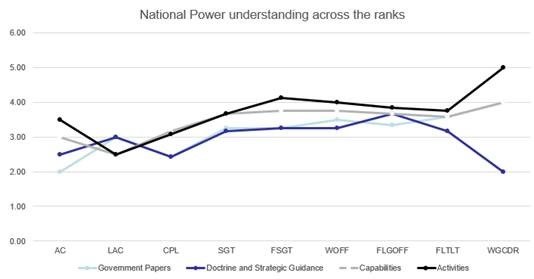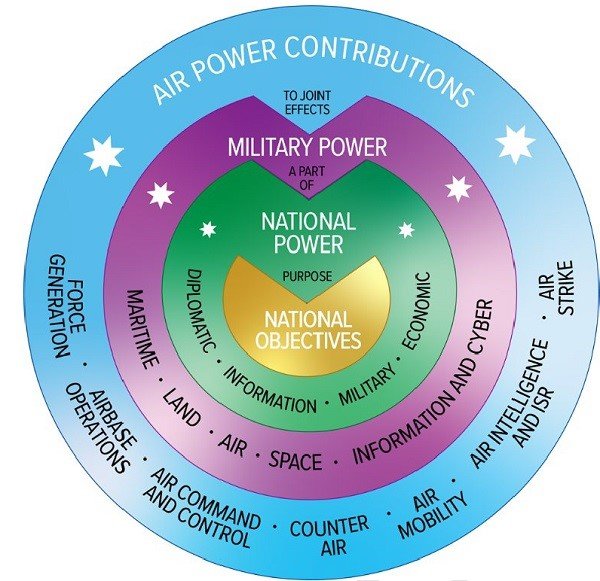Effective realisation of national power in support of Australia’s national interests requires all Aviators to have a clear understanding of their contribution on a macro-level in order to work together towards it as a shared goal.
A member’s comprehension of Air Force’s role in achieving national power and, by extension, the member’s understanding of their own contribution and that of their Unit and FEG is integral to the successful realisation of Air Force strategic objectives; explicitly Air Force Strategy (AFSTRAT) Line Of Effort (LOE) 1 and 2.
So to what extent does the workforce understand these concepts? To find out, a survey was conducted across a number of Air Force Units; 1CCS, JEWOSU, SPS, and HRIS. The survey asked respondents questions to identify:
- How well they understood what national power is.
- How well they understood Air Force’s contribution to national power in terms of:
- government papers
- doctrine and strategic guidance
- capabilities (mustering’s, specialisations and assets)
- activities (operations and exercises)
- How well they thought someone of their rank should understand national power.
The survey used a scale of 1 – 5 to indicate understanding, with the below ratings.
- 1 - No understanding
- 2 - Limited understanding
- 3 - Could follow a conversation with colleagues
- 4 - Could contribute meaningfully to conversations
- 5 - Could deliver a brief to their unit.
Survey results
The data collected from the survey has been presented through two graphs. Figure 1 shows each rank’s perceived understanding of national power on the scale of 1-5. A takeaway from this graph is that the understanding of national power increases as one progresses through their career. In addition, the mode of national power we understand the most is in our activities followed by capabilities, doctrine, strategic guidance and lastly government papers. Air Force members have the best understanding of national power due to their everyday interactions with capabilities and activities. The written form represents the weakest understanding.

Figure 1. Perceived understanding of national power
Figure 2 compares a member’s actual understanding of national power to what they think their rank should understand. The first key takeaway is all ranks think they should have a better understanding of national Power than they currently do. This is reflected by the gap between the light and dark blue lines. The gap widens as the two rank structures progress which indicates as rank increases, they think they should have a better understanding of national power.

Figure 2. Actual understanding of national power
Survey insights
So what does this data tell us in terms of gaining more insight into what our junior ranks understanding of national power is in relation to the above mentioned survey questions?
The Air Power Contributions Framework from the newly released Air Power Manual 7th Edition at Figure 3 displays national power with the DIME model circling a ‘core’ of national objectives being fed from an outer circle of projected air power contributions. It is evident from the survey that the junior workforces’ understanding of national power is more aligned to their contributions to the military element in particular, compared to their contributions to the other elements of the DIME construct. This finding was not surprising. Could we then argue their ‘awareness’ of the other elements are just as important and their contributions to them are more prevalent than they think?

Figure 3. Air Power Contributions Framework pp.4-1 Air and Space Manual 7th, Edition
The survey also identified insignificant gaps between both a junior and senior ranks understanding of capabilities, showing that this is not an issue at any level of the workforce. The reason for this? In our opinion this could be due to a few emerging factors.
We can see plausible correlations from PMET09 to the implementation of Program Wirraway (PME) in terms of evolving a focus on expanding our junior workforces understanding of capability, operations and deployments. We assess that this provides an understanding from the previous Level 2 content that was entry level PME (CPL/PTOFF, FLGOFF) of PMET09 to introducing discussions and wider Air Force understanding at PME level 1 (AC/W, LAC/W). We are certainly moving towards creating a better baseline understanding earlier on in our aviator’s careers. This has enabled the junior workforce the opportunity to understand the ‘joint’ or indeed the wider Air Force picture, and how to implement discussion and understanding on how they contribute or ‘fit’ in terms of the wider Air Force and the ADF as a whole. This has enhanced their baseline understanding to national power towards strategic effects from the outset which further complements AFSTRAT intent and complements strategic acumen at junior ranks. Joint PME (JPME) has also re-aligned to include lower rank levels as part of creating this awareness earlier on in a member’s career.
Even though this shift has significant effects on how we influence a junior workforces understanding of their effects of national power since 2019, it is important to note that PME and JPME cannot solve all of our professional educational gaps. Particularly when it comes to junior workforces understanding of national power. As demonstrated in Figure 1 there are gaps shown in the survey results in relation to strategic guidance and government papers. The deficit and solution clearly lays in the shift between our junior workforce having an ‘awareness’ of versus actual comprehension of guidance such as CAF guidance, AFSTRAT and other governmental papers including the Defence White Paper 16 and Defence Strategic Update.
The introduction of AFSTRAT at PME level 2 to compliment LOE 2 and LOE 4 in order to bring the workforce to a level where strategic acumen is obtainable and most importantly understandable for the junior workforce, will create larger buy in for our juniors to understand national power. We are already becoming an organisation moving from a foundation of platform-centred comprehension of capability to a wider, more contemporary understanding of joint effects contributing to national power.
So What?
The gaps that were identified have already begun to be addressed by some initiatives such as the transition to updated PME—though formal PME can only form one part of the solution. Available courses that have strong links to strategic-mindedness such as Introduction to Joint Operations provide ways for the junior workforce to develop their knowledge. The transition of this course and others like it to an online environment, without the need for specific contact hours allows training to be available when individuals have the opportunity.
Formal courses aren’t necessarily why areas such as activities rated higher in the survey but rather the level of engagement individuals have with this topic over large, strategic level documents. It’s no surprise that crew room conversations are more likely to focus around recent trips or new platforms as opposed to government papers and strategic guidance; therefore, when planning training, either for specific courses or an ongoing Unit development plan, emphasis should be placed on these areas to compensate for the expected lack of social conversation. They should be discussed at a conversation level by instructors where appropriate so they are not seen as documents that are simply left to those of a higher rank.
In conclusion, individuals should be encouraged to regularly revisit concepts of national power relevant to their rank and experience level. Individuals should also be empowered to have more conversation around them and within their workplace, and not be intimidated by a document just because it contains strategic concepts. Developing an individual’s understanding of national power that is appropriate for their rank and experience is vital in ensuring the realisation of AFSTRAT LOE1 and LOE2.
Comments
Ex back
I really want to thank Dr Emu for saving my marriage. My wife really treated me badly and left home for almost 3 month this got me sick and confused. Then I told my friend about how my wife has changed towards me. Then she told me to contact Dr Emu that he will help me bring back my wife and change her back to a good woman. I never believed in all this but I gave it a try. Dr Emu casted a spell of return of love on her, and my wife came back home for forgiveness and today we are happy again. If you are going through any relationship stress or you want back your Ex or Divorce husband you can contact his email emutemple@gmail.com or WhatsApp +2348071657174
Https://web.facebook.com/Emu-Temple-104891335203341
Add new comment